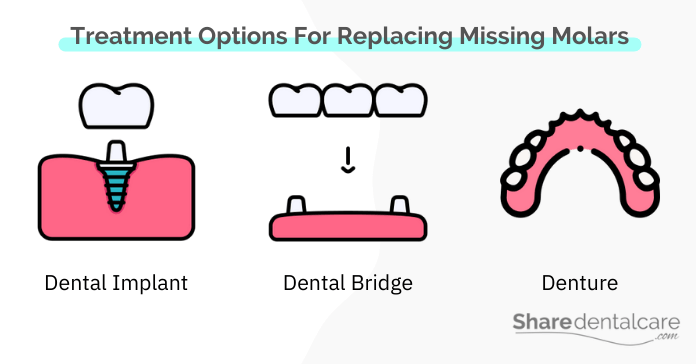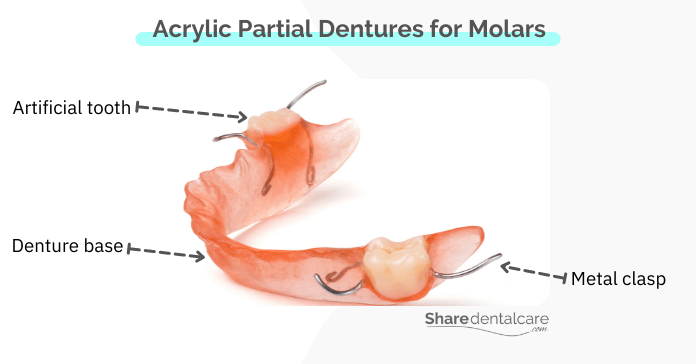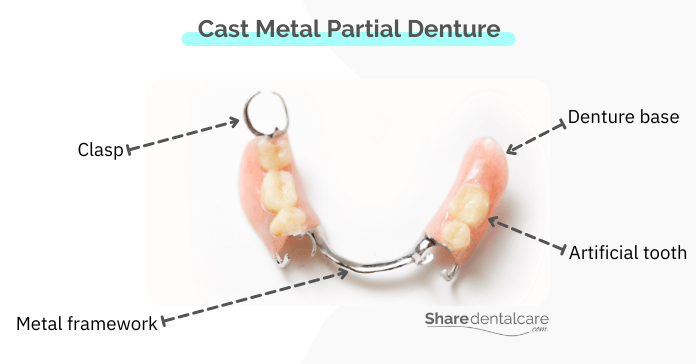Partial dentures for molars are a good way to replace missing posterior teeth. While partial dentures are not as common as other dental treatments, their cost-effectiveness makes them a good alternative to implants or bridges, especially if you want to replace multiple posterior teeth. Partial dentures help fill in some of the gaps left by missing teeth, and they can be perfect for those who have trouble chewing or talking. Also, they don’t require as much work or skill on the part of your dentist, but you must take proper care of them to ensure they last as long as possible. So, understanding their benefits and drawbacks can help you make the decision that will be best for your particular needs.
What Are The Treatment Options For Replacing Missing Molars?
Here are different types of tooth replacement for missing posterior teeth (premolars & molars), as well as the benefits and drawbacks of each option.
- Dental implants: the dental implant is a titanium screw that replaces the root of the tooth, and it is inserted directly into your bone. Implants are expensive, but they last a lifetime. This option doesn’t work well for everyone because it involves surgery. Dental implants can be made from titanium or zirconia.
- Fixed dental bridges: they are the most common option for replacing missing molars. The bridge is anchored to healthy teeth on either side of the gap; the missing tooth or teeth are replaced with artificial ones that fit over them. The cost can vary depending on how many molars are being replaced and where you live. Fixed bridges last and don’t require surgery, so it’s worth considering. Find out how a bridge for back teeth works.
- Removable dentures: A denture is a dental prosthesis that replaces the missing teeth and gums. The disadvantages of dentures include the fact that they aren’t as stable as bridges or implants, so they may feel like they’re falling out or not fitting correctly. Dentures are less expensive than the other options. Types of Dentures include:
- Conventional complete dentures: they are used to replace all of the upper and/or lower teeth.
- Partial dentures: they are used to replace one or more missing teeth such as missing molars. Learn more about single molar denture.

What are Partial Dentures & Their Types to Replace Missing Molars?
Partial dentures are removable appliances that can replace the missing upper and/or lower molars. They can help you restore the chewing function. Partial dentures are less expensive than other options for replacing molars. However, they might not be as stable as implants or bridges, so it’s easier to dislodge them if you eat too quickly or chew on hard objects.
Conventional partial dentures consist of an acrylic base with artificial teeth. They also have metal clasps that hold onto your teeth. The acrylic partial dentures can withstand biting pressure from molars, but they can break if you bite down too hard on hard objects or accidentally hit them against something. If you have missing posterior teeth (molars), there are 3 types of partial dentures you can choose from:
- Acrylic partial dentures: the denture is made of pink-colored acrylic material. Acrylic dentures are easy to make and adjust. They are also less expensive than other types but are fragile and prone to damage.
- Cast metal partial dentures: this type has a metal base (cobalt-chromium alloy). Metal dentures are stronger and thinner than acrylic dentures. However, they are more expensive than acrylic dentures.
- Flexible partial dentures: this type is made of material called Valplast, which is thinner and more flexible than metal or acrylic dentures.

What Are The Pros & Cons of Using Partial Dentures for Missing Molars?
- Pros: Partial dentures are less expensive than bridges or implants. They also can be cleaned easily. Partial dentures don’t require as much work or skill on the part of your dentist, but you must take proper care of them to ensure they last as long as possible.
- Cons: Partial dentures for molars are removable and don’t last as long as other options, such as dental implants and bridges, so you’ll have to replace them more frequently. You must visit the dentist every year or two for a checkup and to have them relined.

How Long Do Partial Dentures for Molars Last?
Partial dentures for missing molars are not as long-lasting as other options, such as dental implants and bridges. They last an average of five to seven years in total with good home care, but this can vary based on your specific circumstances. So you’ll need to visit the dentist every year or two for a checkup and to have them relined.
Oral Health & Partial Denture For Molars
You should keep your mouth clean while using partial dentures to prevent any complications. Here are some tips to keep your mouth healthy and partial Partial dentures for missing molars clean:
- Brush your teeth twice a day and floss at least once every day.
- Wash your dentures with warm water, mouthwash, or denture cleaning solution after each meal.
- Wash your teeth and denture daily with a soft-bristled brush and toothpaste. Partial dentures should be brushed using only a soft brush since hard-bristled brushes could damage the dentures.
- Clasps may also be cleaned between meals using a soft-bristled brush and toothpaste. Avoid using brushes that have sharp edges or pointed tips since they could damage the clasps.
- Don’t let your gums bleed while using partial dentures for missing molars. Bleeding gums might be a sign of gum disease or irritation from your partial dentures. If your gums bleed when you use your partial dentures, try changing the way that you brush them to avoid further irritation.
- Partial dentures for molars should be removed before going to bed, swimming, and showering.
- They should always be stored in a clean, dry place after use.
- Consult with your dentist immediately if you notice that your partial dentures are loose or shifting, because they may need relining or adjustment.
Conclusion
If you have missing posterior teeth (molars), partial dentures could be a good option for replacing them. Partial dentures can fill the gaps left by missing posterior teeth and restore the chewing function. They are also less expensive than other treatment options. However, compared to other options, partial dentures are less stable and don’t last as long as dental bridges and implants. Consult your dentist to know if partial dentures for posterior teeth (molars) are suitable for you.